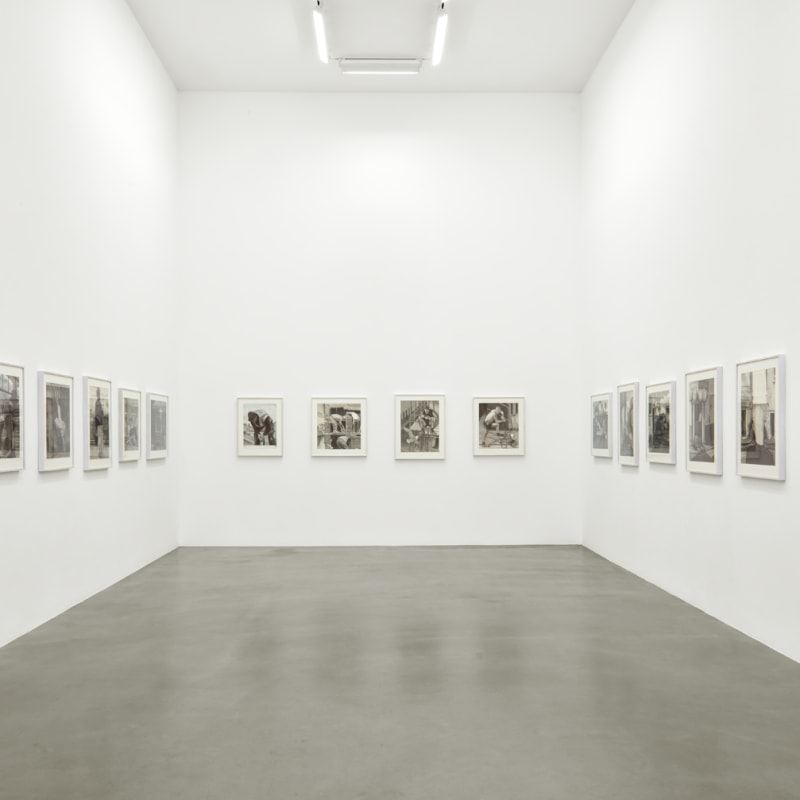In January 2020, Sadie Coles HQ will present an exhibition of drawings by Paul Anthony Harford (1943-2016). Titled Real Life, the display focuses on the elements of social realism and close observation that run through Harford’s work – as reflected by his fascination for the incidental, the everyday and the offbeat. Dating primarily from the 2000s, the drawings capture the characters and environments of the seaside towns where he spent much of his life, oscillating between humour and subdued melancholy.
Harford, who trained at Byam Shaw School of Art in the 1960s, resisted opportunities to exhibit during his lifetime. Working variously as a schoolteacher, cleaner, binman and porter, he dedicated his remaining time to the creation of meticulous graphite drawings – amassing hundreds of works over the course of his life. His surviving drawings are invariably touched by his experiences in the towns of Weymouth and Southend-on-Sea. Drawn from photographs, observation and memory, their small-scale settings and incidents are refracted through a precise graphic style to become faintly uncanny, absurd or macabre.
Harford typically evoked a sedate world inhabited by anonymous people, and yet the ‘real life’ of his scenes frequently appears precarious, set to unravel. The novelist Shena Mackay, Harford’s former sister in law, has described the setting of his drawings as “Harfordville-on-Sea, the coastal town he has made his own, laying claim with graphite to the inhabitants of its flats and boarding houses, and to its eccentric seaside architecture.” Within this liminal realm, people are glimpsed in the midst of daily work: three builders bend over on a scaffold while seagulls glide past; a woman hoovers before an open door; a workman rests one leg on a wheelbarrow containing a skull – the shirtless labourer becoming a gravedigger in modern guise.
Harford’s scenes often tilt in this way from the everyday into the incongruous. Certain drawings incorporate surreal or violent elements that conjure a fable-like mood: a man is seen tumbling out of a hearse, clutching a stamped letter, while a vulture perches on his chest and claws at his face; elsewhere, the bonnet of a Rolls Royce edges out of a stately front door while a figure lies collapsed on the pavement beyond. In many cases, Harford captured people in transient states or spaces – riding on trains or buses – or suspended in moments of inaction and inertia: a man looks out of a window into slanting seaside light, a cigarette in his hand; men sleep in deckchairs.
Harford’s drawings convey such scenes – whether mundane or awry, or both – with crisp objectivity, employing subtle (at times almost photographic) gradations of tone. Often, he heightened the anonymity of his human subjects by portraying them from oblique angles or by cropping their heads from view: real life is rendered as a sequence of fragments, witnessed elliptically and never fully graspable. In one work, a man bends over apparently to pickpocket a banknote from a passer-by (or perhaps to return a dropped note: the import is unclear) while a Dalmatian sniffs a polystyrene tray on the pavement below. All the while, however, Harford’s presence as an onlooker and a chronicler is discernible – whether in the wry humour or latent unease of the scenes he depicts, or more explicitly, the art historical references that seep into certain works.
Paul Anthony Harford was born in Weston-Super-Mare in 1943. In the 1970s, he was drawn to the Southend area, where he spent twelve years, working as an art teacher in Westcliff-on-Sea. He later moved to Weymouth, where most of his surviving work was completed. In 2015 he returned to Southend. His work was the subject of a survey exhibition, Other Voices, Other Rooms, at Focal Point Gallery, Southend, in early 2018, which was followed by an exhibition at Sadie Coles HQ later that year.
For further information please contact the gallery at +44 (0)20 7493 8611 or press@sadiecoles.com
